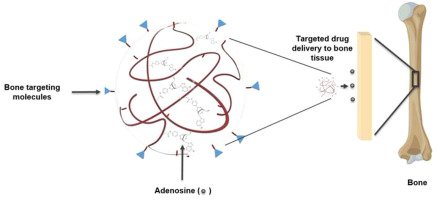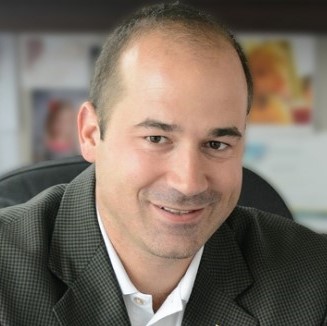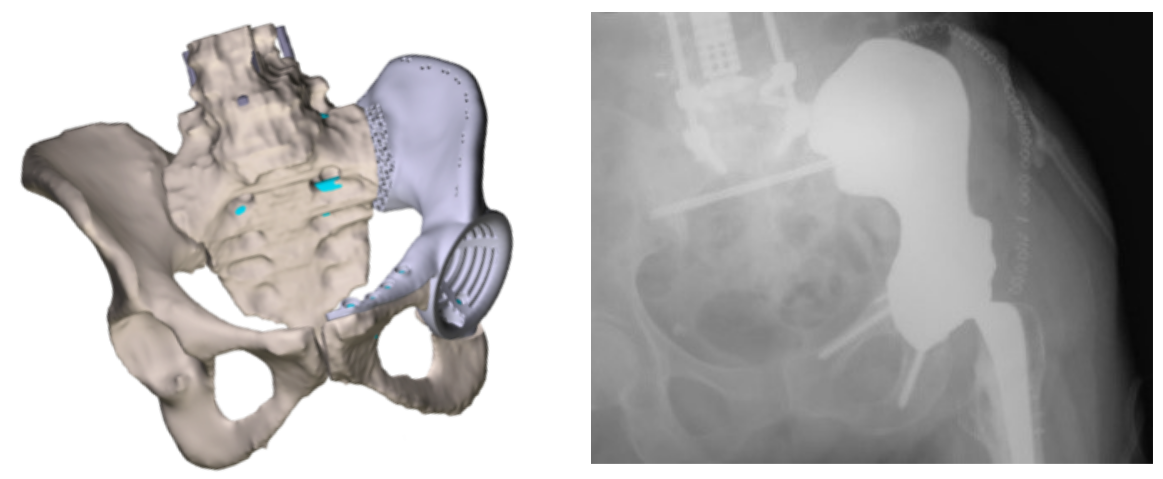Developing Biomaterial Implants to Improve Human Health
Elizabeth Witherspoon
Duke materials scientists combine engineering and medicine to treat bone injury, disease, pain and more
An injectable that prompts bone regeneration. A biodegradable patch inside a surgical wound that relieves pain. A 3D-printed replacement for a crushed ankle. These sound more like props in a science fiction movie than the products of present-day engineers.
Yet three faculty members in the Thomas Lord Department of Mechanical Engineering & Materials Science at Duke are turning these and other biomaterial implant projects into realities.
Working at the intersection of engineering and medicine, they are spinning out state-of-the-art advances and even companies to deliver solutions to unmet medical needs.
This cutting-edge work includes molecular level technology to activate the body’s own repair process to heal bone fractures and classical chemistry to develop specialized polymers to perform precise functions within the body. Novel structural engineering is combined with materials science to develop 3D-printed lightweight replacements for bones and joints that have the strength to withstand the powerful forces of walking and running.
In each case they collaborate closely with physicians. They all chose to work at Duke University specifically because of the ease with which Duke Engineering and Duke School of Medicine faculty work across disciplines—and across the street—from one another.
Read more about what these researchers are doing to improve lives:

Shyni Varghese
Activating Mechanisms to Heal Bone Fractures and Reverse Osteoporosis
Professor of Biomedical Engineering, Mechanical Engineering & Materials Science and Orthopaedic Surgery
W
ith triple appointments in the Departments of Biomedical Engineering, Mechanical Engineering & Materials Science and Orthopaedic Surgery, Shyni Varghese pursues research at the nexus of engineering, physical sciences and medicine. In particular, she conducts basic science research and translates discoveries into new therapies.
She became Duke University’s first MEDx Investigator when she arrived in 2017 to further work based upon her discovery that adenosine, a biomolecule produced naturally by the human body, plays a large role in spurring bone growth. Varghese has since led her group to engineer a bandage for surgeons to implant at the site of a bone fracture that capitalizes on the body’s production of adenosine, holding it at the injury site to accelerate the natural healing process. She has a patent pending for an injectable system for the same treatment, which would enable primary care physicians and other healthcare providers to administer the therapy to patients with compromised bone healing and traumatic injuries.
 Further building upon this knowledge, Varghese is also working on a non-hormonal small-molecule drug that activates the same biochemical receptor to treat bone loss associated with osteoporosis. Unlike current treatments, which only slow down bone loss, the drug tested by Varghese’s group has so far shown in animal studies the ability to reverse it and spur the body to rebuild bone. Her group has also developed a targeted nanocarrier system to deliver the drug directly to the bones, which overcomes some of the challenge of adenosine’s rapid breakdown in the bloodstream and other off-target effects.
Further building upon this knowledge, Varghese is also working on a non-hormonal small-molecule drug that activates the same biochemical receptor to treat bone loss associated with osteoporosis. Unlike current treatments, which only slow down bone loss, the drug tested by Varghese’s group has so far shown in animal studies the ability to reverse it and spur the body to rebuild bone. Her group has also developed a targeted nanocarrier system to deliver the drug directly to the bones, which overcomes some of the challenge of adenosine’s rapid breakdown in the bloodstream and other off-target effects.
Varghese also has research in the pipeline on how to use this therapy to reduce pain following orthopedic surgery and injuries. The opioid addiction crisis has driven many researchers to look for alternatives, and Varghese has found that this therapy activates a pathway that raises the threshold of pain tolerance.
Other work of her lab includes self-healing hydrogels, which could enable implants and biomaterials to repair themselves. One specific application the group is pursuing is self-repairing lubricants to treat joint injuries.
“I like to dream and find a solution to things. I need to know ‘Why?’ and ‘How?’ I also have a very strong interest in mentoring students.’’

Matthew L. Becker
Developing Bioactive Polymers to Address Unmet Medical Needs
Hugo L. Blomquist Distinguished Professor of Chemistry, Professor of Mechanical Engineering & Materials Science
M
atthew Becker is an expert in organic polymer chemistry whose multidisciplinary research team works at the interface of chemistry, materials and medicine to develop bioactive polymers to improve human health. A professor with joint primary appointments in the Departments of Chemistry and Mechanical Engineering & Materials Science with collaborators in the Departments of Biomedical Engineering and Orthopaedic Surgery, he both conducts basic science research and develops functional biomaterials for translation into clinical applications.
For example, he is currently designing a biocompatible implantable polymer surgical patch that releases a controlled dose of non-opioid painkillers directly to the site of a surgical wound and then dissolves slowly. The goal is to provide localized pain control in the days immediately following surgery, such as for a hernia or cesarean birth, effective enough to eliminate the need for opioid pain relievers and their associated systemic side effects or risk of addiction.
 Becker also is developing 3D-printable polymers for clinical applications, such as implantable mesh used in hernia surgeries. Another project involves biocompatible resins to provide patient-specific scaffolds for repair of the cranium (seen left). In addition, he is working on the basic science to improve the underlying structure of hydrogels for potential use in a wide range of biomedical implant applications. Plus, he is collaborating with Joseph Fernandez-Moure, M.D., assistant professor of surgery at Duke School of Medicine, on an adhesive for injection into broken ribs that would stabilize them during healing and then slowly be absorbed by the body.
Becker also is developing 3D-printable polymers for clinical applications, such as implantable mesh used in hernia surgeries. Another project involves biocompatible resins to provide patient-specific scaffolds for repair of the cranium (seen left). In addition, he is working on the basic science to improve the underlying structure of hydrogels for potential use in a wide range of biomedical implant applications. Plus, he is collaborating with Joseph Fernandez-Moure, M.D., assistant professor of surgery at Duke School of Medicine, on an adhesive for injection into broken ribs that would stabilize them during healing and then slowly be absorbed by the body.Becker has founded three start-up companies—3D BioResins, 3D BioActives and Fortem—under the holding company 21st Century Medical Technologies. He was awarded the 2019 Carl S. Marvel Award in Creative Polymer Chemistry from the American Chemical Society.
“I was drawn to working at Duke University because of its proximity to Duke Medical School–in mindset as well as physically. The collaborative environment here is the best I’ve ever seen, from sharing ideas to sharing resources.”

Ken Gall
Developing Materials and Porous Structures for Medical Implants to Repair Human Bone and for Other Applications
Professor of Mechanical Engineering & Materials Science
Associate Dean for Entrepreneurship, Pratt School of Engineering
K
en Gall is a serial entrepreneur who has started six companies based upon his innovations in developing load-bearing materials and 3D structures for medical implants to support the human skeletal system. Major publicly traded biotechnology companies have acquired three of these companies—most recently DJO, a subsidiary of Colfax Corporation (NYSE: CFX), which acquired MedShape, Inc.—to make these advances even more widely available to patients.
Gall’s research has produced metal alloy implants that have prevented leg amputation, reconstructed a pelvis ravaged by cancer and restored knees and ankles that have suffered severe traumatic injury.
 He is an expert in 3D printing of metals and polymers. 3D-printed metals allow the creation of high-strength, porous structures that have the strength to carry loads as well as the responsiveness of live bone tissue, enabling effective orthopedic repairs and reconstructions.
He is an expert in 3D printing of metals and polymers. 3D-printed metals allow the creation of high-strength, porous structures that have the strength to carry loads as well as the responsiveness of live bone tissue, enabling effective orthopedic repairs and reconstructions.
Gall translates his basic materials research into implants using 3D-printing, laser powder bed fusion and other additive manufacturing methods to customize implants to specific patient needs. With Duke colleague Ben Wiley, he has also developed a hydrogel material (water-absorbing polymer) that can withstand the enormous forces equivalent to those encountered by the human knee, providing a potential alternative to knee replacement surgery.
“As a mechanical engineer, I am interested in developing materials and structures that can not only support tissue growth but also carry substantial forces. The strong link between the medical school and engineering school here at Duke enables us to both innovate at the basic science level and translate it into life-changing clinical applications.”
Not only are the implants Gall is developing strong enough to support loads, but they also promote healing. Gall has developed complex porous metal and polymer structures that encourage bone and tissue ingrowth. He also has developed 3D-printed orthopedic device implants for controlled release of antibiotics to treat infection around artificial joints.
With the onset of the global pandemic and shortage of personal protective equipment (PPE) for health care workers, Gall collaborated with Duke Engineering professors Paul Fearis and Eric Richardson to develop a solution. Working around the clock, they tested prototypes and 3D-printed parts to convert existing surgical helmets, which use room air, into powered air-purifying respirators, which use filtered air.
Gall is currently working on a high-strength polycarbonate urethane mesh with elastic properties as an alternative to the stiffer polypropylene meshes currently used to treat pelvic organ prolapse in women.
He is also collaborating with Duke colleague Guillermo Sapiro to use machine-learning approaches to understand the alignment of, for example, healthy ankle bones, and use that information both for building patient-specific 3D-printed implants and for guiding physicians during reconstruction of patients’ ankles after severe trauma. In addition, Gall and Duke colleagues Cate Brinson and Cynthia Rudin are exploring ways to use machine learning to predict the properties of 3D structures, which may help improve biomaterial implant design.
Other collaborations include those with Duke colleague Matthew Becker (above) on advanced manufacturing approaches for specific scaffolds for repairs across the spectrum of musculoskeletal injuries and artifical intelligence-directed resin design in a way that has not been done previously.
As the associate dean for entrepreneurship, Gall is leading the Pratt School of Engineering’s Engineering Entrepreneurship (EngEn) initiative that integrates design experiences, entrepreneurial education, startup resources and an expert team to support faculty and student founders. A goal of the initiative is also to train the next generation of founders and to deliver technical solutions for society’s needs in health, defense, climate change and beyond.
